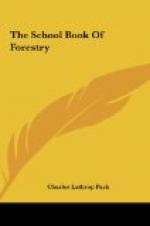Agricultural and forestry experts have surveyed the lands in the National Forests. Thus they have prevented the use of lands for forestry purposes which are better adapted for farming. Since 1910, more than 26,500,000 acres of lands have been excluded from the forests. These lands were more useful for farming or grazing than for forestry. Practically all lands within the National Forests have now been examined and classified. At intervals Congress has combined several areas of forest lands into single tracts. Government lands outside the National Forests have also been traded for state or private lands within their boundaries. Thus the forests have been lined-up in more compact bodies. Careful surveys are made before such trades are closed to make sure that the land given to Uncle Sam is valuable for timber production and the protection of stream flow, and that the Government receives full value for the land that is exchanged.
The National Forests contain nearly five hundred billion board feet of merchantable timber. This is 23 per cent. of the remaining timber in the country. Whenever the trees in the forest reach maturity they are sold and put to use. All green trees to be cut are selected by qualified forest officers and blazed and marked with a “U.S.” This marking is done carefully so as to protect the forest and insure a future crop of trees on the area. Timber is furnished at low rates to local farmers, settlers, and stockmen for use in making improvements. Much fire wood and dead and down timber also is given away. The removal of such material lessens the fire danger in the forest.
Over a billion feet of timber, valued at more than $3,000,000, is sold annually from the National Forests.
One generally does not think of meat, leather and wool as forest crops. Nevertheless, the National Forests play an important part in the western livestock industry. Experts report that over one-fifth of the cattle and one-half of the sheep of the western states are grazed in the National Forests. These livestock are estimated to be worth nearly one-quarter billion dollars. More than 9,500,000 head of livestock are pastured annually under permit in the Federal forests. In addition, some 4,000,000 to 6,000,000 calves and lambs are grazed free of charge.
[Illustration: Seed beds in A forest nursery]
The ranges suitable for stock grazing are used to pasture sheep, cattle, horses, hogs and goats. The Secretary of Agriculture decides what number and what kind of animals shall graze on each forest. He regulates the grazing and prevents injury to the ranges from being overstocked with too many cattle and sheep. The forest ranges are divided into grazing units. Generally, the cattle and horses are grazed in the valleys and on the lower slopes of the mountain. The sheep and goats are pastured on the high mountain sides and in the grassy meadows at or above timberline.




